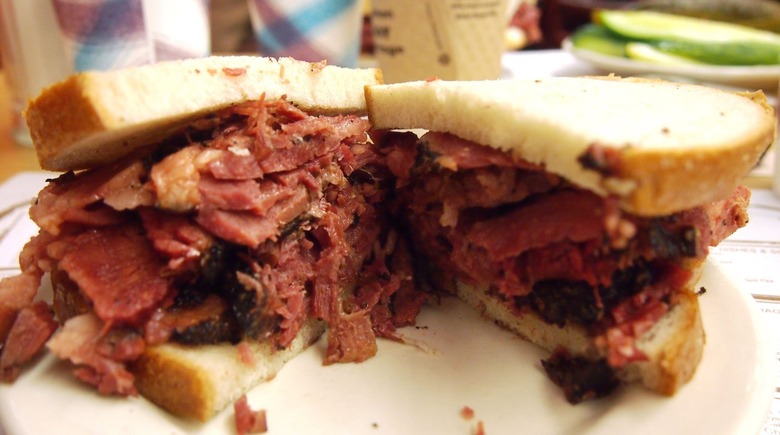We Bet You Have No Idea How Corned Beef And Pastrami Are Made
In the canon of traditional Jewish-American deli fare, corned beef and pastrami rank at the top of the heap. As opposed to some more, shall we say, challenging foods, like creamed herring, these ones are nearly impossible to dislike, and make for one heck of a sandwich when piled between two slices of rye bread with a little mustard. But do you have any idea how corned beef and pastrami are made? Because it's a lot more complicated than you probably think.
First, let's look at corned beef. Corned beef starts with a brine, which contains sugar, salt, garlic, and spices including mustard seed, peppercorns, cloves, allspice, and juniper, as well as some "pink salt" which helps cure the meat and gives it that distinctive red color. A whole brisket is submerged in the brine, and it's left to set in the refrigerator for a week or so (the corned beef at New York's legendary Katz's goes for a full month). After it comes out of the brine, it's rinsed and simmered in a pot of water (usually with some onion, carrots, and celery mixed in) for up to 3 hours, or until it's fork tender. Then it's sliced and served.
The pastrami-making process is even more complicated. Like corned beef, it starts with brisket (or sometimes the fattier navel), and it's brined for slightly less time than corned beef. But instead of going straight into boiling water, it's first rubbed with a spice mix that's heavy on black pepper, onion, garlic, and coriander, and smoked low and slow for up to three days. It's then boiled until nearly falling apart, and then in some cases (like at Katz's) it's steamed for 15 minutes or so until ready to slice.
You can always try to make your own, but we suggest you visit one of America's best Jewish delis instead.
